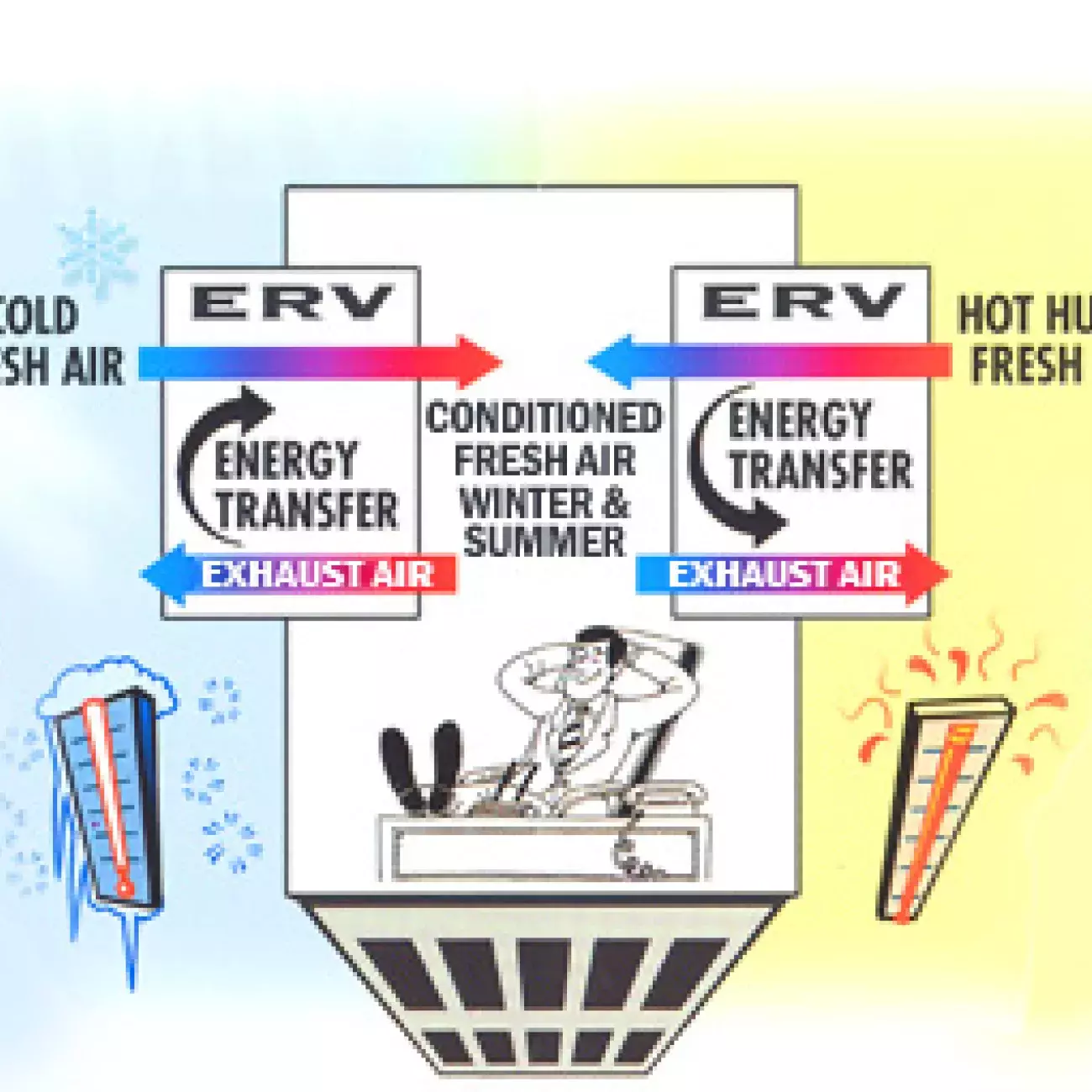Energy Recovery Ventilators
Energy recovery ventilators (ERVs) and heat recovery ventilators (HRVs) are mechanical ventilation systems that use fans and other technology to maintain a constant flow of fresh outdoor air into the house, while exhausting stale indoor air. They also use technology to use the conditioned, stale indoor air that is being exhausted to cool or warm incoming, fresh outdoor air. Pre-cooling or pre-warming the incoming air helps decrease the demand on the home’s heating and cooling system to help save energy.
How it Works
Although some window or wall-mounted units are available, HRVs and ERVs are most often designed to be placed in the ducts of a whole-house heating and cooling system. The heat exchanger is the heart of an HRV, usually consisting of a box-shaped transfer unit made from special conductive materials. Incoming and outgoing air streams pass through different sides of the box (but are not mixed), allowing conditioned exhaust air to raise or lower the temperature of incoming fresh air. ERVs also allow the exchange of moisture to control humidity. This can be especially valuable in situations where problems may be created by extreme differences in indoor and outdoor moisture levels. For instance, in cold climates better air flow and additional humidity inside can help control window condensation. In humid summer climates, it can be critical to dry out incoming air so that mildew and mold do not develop in ductwork.

After passing through the heat exchanger, the warmed or cooled fresh air goes through the HVAC air handler, or may be sent directly to various rooms. Stale air from return ducts warms or cools the incoming air, depending on the season, before being exhausted outdoors.
Conventional fan and vent units, often required by code in baths and kitchens, may allow significant energy losses. An HRV system can incorporate small, separately switched booster fans in these rooms to control moisture or heat generated by activities like showering or cooking. Odors and pollutants can be quickly removed, but energy used to condition the air is recycled in the heat exchanger. Some codes or applications may still require stoves to be separately vented for removal of grease or gas fumes.
Size Requirements
ERVs are typically sized to ventilate the whole house at a minimum of .35 air changes per hour. To calculate the size needed for your home, simply take the square footage of the house (including basement) and multiply by the height of the ceiling to get cubic volume. Then, divide that figure by 60 and multiply by .35 to obtain the appropriate size.
Quality Installations
If you are building a new house or remodeling, ask your building contractor about the mechanical ventilation options or check the yellow pages for heating and cooling contractors. A quality installation by a knowledgeable contractor will include locating the fresh air intake away from driveways, laundry rooms and furnace vents; installing a supply inlet (dedicated inlet or heating register, if connected to forced air) for each bedroom and one for each common area; and installing a return outlet in each high moisture area such as the kitchen, bathroom and laundry room; returning outlets (pick-up points) should be within one foot of the ceiling and 10 feet away from an oven or cook top, as vaporized grease could clog the energy recovery core. In addition, the contractor should keep duct runs as short and straight as possible; use smooth, round ductwork when possible; insulate intake/exhaust and any ventilation ducts in unheated spaces and seal all joints; and install a drain to catch any condensation, if required.
Maintenance
Check the owner’s manual, but typically maintenance can be done by the homeowner and includes cleaning or replacing air filters every one to three months, cleaning or unblocking outside hoods and screens every 13 months, cleaning the energy recovery core every six months (in many cases this can be done with a standard vacuum cleaner), and cleaning the condensate drain and pans every six months. Annually, homeowners should have a heating and air-conditioning contractor service their unit and clean the fans and grills, inspect ductwork for any leaks or obstructions, and verify that the system is properly balanced.